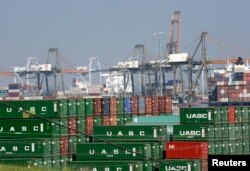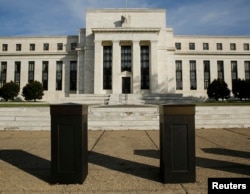The U.S. economy advanced a solid 2.3 percent in the April-to-June period after a harsh winter.
The Commerce Department reported Thursday that a surge in consumer spending and new export gains pushed the world's largest economy ahead in the second quarter.
The government also said GDP in the January-March period grew 0.6 percent instead of shrinking at a 0.2 percent pace.
Second-quarter growth was fueled mainly by a solid increase in U.S. consumer spending, which accounts for 70 percent of the country's economy, advancing 2.9 percent compared to the 1.8 percent growth in the January-to-March period.
Exports rebound
There was also a major turnaround in exports, which had been hit in the first quarter by the West Coast ports slowdown that choked traffic.
Exports of goods and services advanced 5.3 percent in the second quarter after plummeting 6.0 percent in the first.
Economists are hopeful about the rest of 2015, too.
They expect overall GDP growth to continue strengthening in the second half of this year to around 3 percent, with consumer spending continuing to grow as employers continue to hire more workers.
"The economic recovery has lasted six years and shows no signs of old age. Most notably job growth is strong and broad-based, and wage increases are set to accelerate more significantly as the economy approaches full employment," said Scott Hoyt of Moody's Analytics.
The latest results mirror a familiar pattern over the last few years. The economy has consistently underperformed in the first quarter and then revved up in the spring and summer.
The uneven momentum has contributed to overall tepid growth since the Great Recession officially ended in June 2009. It's been the slowest recovery since World War II.
Thursday’s report is in line with forecasts released the day before by the U.S. central bank, the Federal Reserve, showing steady economic gains, and gives rise to speculation about the timing of the Fed’s plan to raise the interest rate it charges prime borrowers.
On Wednesday, the Fed noted that the job market, housing and consumer spending have all improved, but it kept its key rate to near zero, where it has remained since 2008.
Gains needed
The Fed said it still needs to see some more gains in the job market and feel reasonably confident that low inflation will move back to its 2 percent target rate.
"The second-quarter U.S. GDP data support the Fed's more upbeat tone on economic conditions and suggests that the economy could cope with higher interest rates," said Steve Murphy, U.S. economist with Capital Economics.
Some analysts said the U.S. economy appeared to have enough momentum to keep the Fed on track for the first increase in more than nine years.
"Updated GDP numbers deliver a double punch to U.S. economy doom-mongers, painting a reassuringly bright picture of the health of the U.S. economy so far this year and raising the odds of the Fed hiking interest rates in September," said Chris Williamson, chief economist at Markit.
Some analysts say the increase in the key interest rate could come as soon as September, but others say the Fed is likely to wait till the end of the year.
The U.S. recovery has been steady, but not robust, since the recession officially ended in 2009. The government said the economy grew just 2 percent annually from 2011 to 2014, down from an earlier estimate of 2.3 percent.
Ken Bredemeier contributed to this report. Some material for this report came from AP and AFP.











